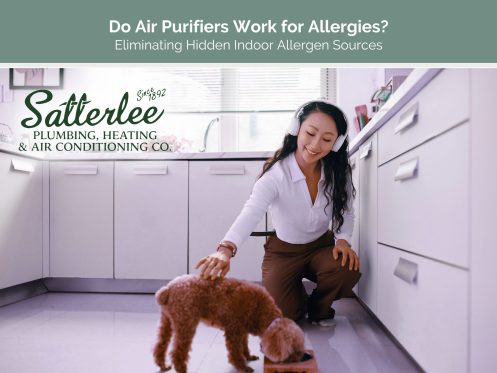Spring and fall in Pittsburg, Kansas, often bring a surge in allergy symptoms for many residents. While outdoor pollen is a well-known trigger, many allergens lurk inside our homes year-round, especially with pets. Are you struggling with sneezing, itchy eyes, or respiratory discomfort indoors? It’s time to consider whether hidden indoor allergens—and your home’s air quality—are to blame. As well as to find out if air purifiers work for allergies. Here’s how air purifiers can help, what hidden allergen sources to watch for, and why working with a trusted HVAC provider like Satterlee Heating and Air is essential for cleaner, healthier air.
Do Air Purifiers Work for Allergies?
Air purifiers, especially those equipped with HEPA filters, are designed to capture fine particles in the air—including many allergens that trigger symptoms. Research shows that air purifiers can reduce levels of indoor particulate matter (PM2.5 and PM10), which include dust, soot, pollen, and smoke. For individuals with allergies or sensitive skin, this can mean fewer and less severe flare-ups. However, it’s important to note that while air purifiers can significantly reduce airborne allergens, they may be less effective for larger particles like some pollen or heavier dust mite allergens. Maintenance is also key—cleaning or replacing filters regularly helps ensure a purifier’s effectiveness. Not to mention, there are additional ways to work in tangent with the efficiency of an air purification system.
How to Identify Hidden Sources of Indoor Allergens
In partnership with an air purifier, taking steps to eliminate sources of indoor allergens can also improve air quality. Many homeowners are surprised to learn just how many allergens are hiding in plain sight. Here are some of the most common—and often overlooked—sources:
- Carpets, Curtains, Blinds, Bedding, and Soft Furnishings
- Carpeting, rugs, pillows, bedding, and upholstered furniture trap dust, pollen, pet fur or dander, smoke, dust mites and mold spores. These soft surfaces are reservoirs of allergens, especially without regularly cleaning them. Items that can’t be washed or are rarely cleaned like fabrics in curtains, blinds, and mattresses are especially problematic.
- Clutter and Stuffed Toys
- Cluttered spaces and stuffed toys can accumulate dust and provide hiding spots for dust mites and cockroach debris. Cockroach droppings, shed skin, and saliva are strong allergens. Food crumbs and clutter often attract these pests and their allergenic particles can settle throughout the home.
- Washer and Dryers
- Dampness and lint in laundry areas can promote mold growth and dust accumulation. Mold spores, like dust mites, are a significant allergen and thrive in damp areas such as bathrooms, basements, kitchens, around sinks and houseplants, inside refrigerators, or anywhere with water leaks or high humidity.
- Air Filtration and Ventilation Systems
- Poorly maintained HVAC systems and dirty air filters can circulate dust, mold, and other allergens throughout the home
Why Consider a Whole-Home Air Purifier for Allergies?
Besides eliminating hidden sources of indoor allergens, choosing the right type of purifier is also crucial. While portable air purifiers can help in individual rooms, a whole-home air purifier offers comprehensive protection by cleaning the air throughout your entire house. Furthermore, these systems integrate directly with your HVAC system, providing several advantages:
- Complete Coverage: Every room benefits, not just the space where a portable unit sits.
- Low Maintenance and Quiet Operation: Whole-home systems are typically quieter, energy efficient, and require less frequent filter changes than multiple portable units.
- Improved Health and Comfort: By removing dust, pollen, mold, and other allergens, these systems can help reduce allergy symptoms and improve overall indoor air quality.
Choosing the Right HVAC Service Provider in Pittsburg
Selecting a reputable HVAC contractor is crucial for effective air purifier installation and ongoing maintenance. Here’s what to look for:
- Licensing and Certifications: Ensure your contractor has a license in Kansas and holds relevant certifications for HVAC and indoor air quality services.
- Experience and Reputation: Look for providers with a strong track record in Pittsburg, like Satterlee Heating and Air, and check customer reviews for reliability and professionalism.
- Comprehensive Services: Choose a contractor offering a full range of HVAC and indoor air quality solutions, including maintenance plans, emergency repairs, and energy-efficient upgrades.
- Clear Communication: A trustworthy contractor will provide written estimates, explain recommendations, and answer your questions clearly.
Breathe Easier with Satterlee Heating and Air
Ready to tackle hidden allergens and improve your home’s air quality? Contact Satterlee Heating and Air! We go beyond residential HVAC inspection, maintenance, or installation services in Pittsburg, Kansas. We also offer whole-home air purifier installation services! Our professional team of technicians is ready to help your family breathe easier—season after season.


